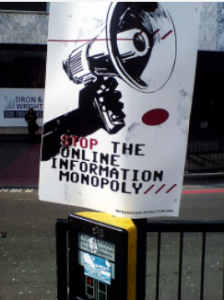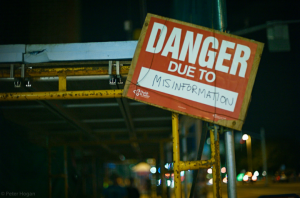Techlash is a term coined firstly by The Economist for describing the new phenomenon that the hostility towards the tech giants is growing, which causes a shift in the tech industry (Mitroff and Storesund, 2020). This assignment analyzes the public concerns that lie behind this term and to what extent can these concerns be addressed by the main stakeholders, including governments, civil society organizations, and tech giants.
Source: fabbio, 2021
The public concerns that lie behind the techlash are mainly as the following. The first is technology monopoly. Although people may easily forget that the platforms of technology companies, such as Google and Baidu, are enterprises instead of pubic forums, there is the fact that the “algorithms” on the websites of the technology dictate the contents people watch, read and listen to. Hence, when there are only several companies that occupy the fields of search engines, social media, and the online shopping market, then the public has a reason to resist such a situation (Van Dijck, Poell & de Waal, 2018).

Source:3dpete, 2021
The second is misinformation. Because of the fast spread speed of the internet, there are more and faster ways to obtain news reports nowadays than before, which also provides a soul for fake news. It is very difficult to investigate whether the article one is reading is accurate or not. When the “fake news”, such as fake articles become the tools for impacting public opinion and even the process of democracy, then it becomes a big issue. Hence, tech companies that carry news have the responsibility to monitor thecontent shared on them. However, the decisions made by such tech companies, such as eliminating what kinds of content also leads to another argument point.

Source:perspec_photo88, 2021
The third is data security. In the aspect of collecting, selling, and using users’ data to impact users’ behaviors, form public opinions, and maintain market superiority, the world has witnessed that tech giants have challenged the Western fundamental value concept, that is, privacy and individual autonomy (Smith, 2020). With the increased adverse news about data leakage, consumers start to care about who owns their information, and how their information will be dealt with. Technology companies are expected to protect the data they collected since the digital footprint of ordinary people is huge and cannot be controlled thereby (Karpf, 2018). Whether technology companies can take the responsibility for the increased demand for internet security is under doubt. The fourth is the impact of technology giant on psychological health. People assume that the products of technology companies can generate negative impacts on their psychological health. For instance, there are Cyberbullies, hatred opinions, and extreme content which may impact people especially the youth. And even smart phones and social media have the features to let people addicted. The contents are in the handle of the relevant technology companies. Hence, the public assumes that they can reconsider their impact on society. Besides, Tech giant companies can not only impact the lives of individuals and society but also be a potential thereat the national sovereignty, such as cryptocurrency which mainly operates outside the scope of government constraints.
For addressing the problems brought by tech giants, the main measures taken by governments include legislative restrictions, antitrust investigations, and high fines, although for now, these measures haven’t achieved a very good effect. Early at the end of the 20th century, the American government conducted several anti-monopoly investigations against Microsoft. In recent years, the developed capitalist countries in Europe and the United States have frequently taken anti-monopoly measures against more active tech giants (Flew, 2018). For instance, Google faces 14 anti-monopoly investigations in the EU and huge fines from the regulators of the EU. And in 2016 EU passed new regulation measures such as the GDPR. The fines on antitrust and privacy violation imposed by America on tech giant is also high. For instance, in 2019, Facebook was fined 5billion USD for privacy disclosure. However, some tech giants even can bargain with governments. For instance, at the beginning of 2021, the Australian government had the intention to curb Google through legislation. However, Google claimed to withdraw from the Australian market. However, viewing from the result, it is difficult to say the measure of investigation plus fine is effective. Because such kinds of measures didn’t let the tech giants lose their power, nor did they promote new market units or bring a new competitive situation. Whats’ more, for developed countries, especially for the United States, the advantages of the monopoly of tech giants even surpass its disadvantages. Therefore, when facing the monitor challenges of tech giants, they not only lack a strong intention but also lack a sufficient realistic demand to solve the issue.
As for civil society organizations, what they do and can do for now is making appeals to tech giants to stop their actions that violate the public. For instance, on May 22, 2018, there was an American civil society organization that appeals to tech giant Amazon to stop provide face identification service to the government and warning that the face identification software Amazon uses may lead to the misuse of civilian data and the violation of privacy. The civil society organizations in the United States worried about the abuse of using face identification software may harm the privacy of the public due to such kind of technology can be used to trace everyone’s behaviors and immigrants and demonstrators may be the potential target (Snow, 2018). Moreover, civil society organizations also appeal to the public’s awareness of their information security online when using tech giant’s platforms. However, because civil society organizations do not have official power, hence, the effect of their appeals is limited, which can just arouse the awareness of the issue instead of directly solving them.
With the increased issues and challenges of techlash and internet security, tech giants also take measures to invest in data security and monitor the contents on their platforms. For instance, in the aspect of data protection, they considered network security plans in both the individual data and enterprise data fields. For facing the problem of internet security, most of the tech giants have adopted the measures of investing internet security area and applying for data security patents. In the past several years, tech giants also have applied a lot of patents, covering the aspects such as user log in credential protection and attacking internet crimes. For instance, Apple embedded the anti-tracking function of intelligent tracking prevention in safari. Meanwhile, it has applied for data security patents and technologies, such as its iABC-AL “privacy leaks threat detection” (Bhatt, Gupta & Mittal, 2021). As for Microsoft, it has launched two programs specifically aimed at election security in America and Europe, such as its defending democracy program. At the same time, Microsoft uses biometric-related tools to ensure the security of data access. In aspect of Facebook, it has recruited professionals to deal with issues such as privacy policies, legislation, and protection. In addition, it pursues AI to improve the data security of its whole organization. Facebook has also launched new tech to assist it to deal with the spread of misinformation. However, deleting what kinds of contents and allowing the existence of what kinds of contents still lead to another concern. The efforts made by the tech giants themselves do have addressed most of the issues concerned, such as data disclosure and anti-democracy contents to a great extent, although the decisions and standards made by them are also under doubt.
In short, governments, civil society organizations, and tech companies themselves all have made efforts to deal with the issues the public has concerns with. All of their efforts have achieved certain success although none of them can address the concerns completely. And global cooperation of all forces is needed for addressing the concerns.
Reference:
Bhatt, A.J., Gupta, C. & Mittal, S. (2021);2018;, “iABC-AL: Active learning-based privacy leaks threat detection for iOS applications”, Journal of King Saud University. Computer and information sciences, vol. 33, no. 7, pp. 769-786.
Fabbio, (2021). Stop the online information monopoly. https://search.creativecommons.org/photos/301dabfc-eee9-465c-9389-0deb07997a75
Flew, T., 2018, ‘Platforms on Trial ‘, Intermedia 46(1), pp. 16-21.
Karpf, Dave (2018) ’25 Years of WIRED Predictions: Why the Future Never Arrives’, WIRED, 9 October. https://www.wired.com/story/wired25-david-karpf-issues-tech-predictions/
King, F. (2019). What is Techlash and what does it mean for the digital industry?Retrieved 11 July 2019 from https://www.balticapprenticeships.com/blog/what-is-techlash-and-what-does-it-mean-for-the-digital-industry
Mitroff, I. I., & Storesund, R. (2020). Techlash: The future of the socially responsible tech organization (1st 2020. ed.). Springer International Publishing.
perspec_photo88,(2021). Data Security – Cyber Crime – Hacking. https://search.creativecommons.org/photos/eb113250-cbec-4084-b0be-277ac92fbf9a
Snow, J. (2018). Technology & Civil Liberties Attorney, ACLU of Northern California. https://www.aclu.org/blog/privacy-technology/surveillance-technologies/amazons-face-recognition-falsely-matched-28
Smith, M. (2020), “Review of Neil Selwyn, Felicitas Macgilchrist, and Ben Williamson. Digital Education after COVID-19. TECHLASH, 1″, Postdigital Science and Education, .
Van Dijck, J., Poell, T. & de Waal, M. (2018) The Platform Society. Oxford: Oxford University Press, pp. 5-32 (‘The Platform Society as a Contested Concept’).
3dpete, (2021). Misinformation. https://search.creativecommons.org/photos/f8d25b38-cdf3-465c-b7a3-0aa950261159

This work is licensed under a Creative Commons Attribution 4.0 International License.